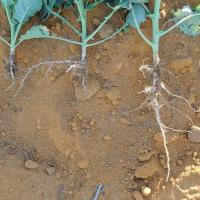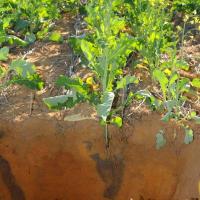Diagnosing soil acidity in crops
There are two main categories of acid soils in Western Australia (WA):
1. Soils where acidification from agriculture is affecting production.
2. Soils that were naturally highly acidic before agriculture: 'Acid wodjil' soils in the east/north-east wheatbelt and acid peaty soils in the south-west.
What to look for
- Growth and yield varies with soil type usually worse on acidic sandy surfaced soils.
Paddock
- Shortened roots, often with thickened ends where they meet the acidic layer, generally below 10 centimetres (cm).
- Reduced growth and tillering.
- Premature maturity and reduced yields, particularly in seasons with a dry finish where plants rely more on stored subsoil water for grain filling.
- Subsoil moisture below the root zone of maturing crop.
- Soil acidity reduces molybdenum availability and to a lesser extent nitrogen, sulphur, phosphorus, calcium and magnesium availability.
- Soil acidity in the surface reduces nodulation in legumes.
Plant
What else could it be
| Condition | Similarities | Differences |
|---|---|---|
| Diagnosing sandplain traffic pan | Reduced root growth in compacted layer. Often occurs with soil acidity | Identified by the presence of acidity by soil test and compaction by probe or penetrometer |
| Diagnosing spring drought in wheat and barley | Can have similar plant symptoms | Causes can be determined by the soil type and location. |
| Diagnosing boron toxicity in wheat | Can have similar plant symptoms | Boron toxicity only occurs on highly alkaline clay soils. |
|
Root diseases and root chewing insects
|
Weak plant and/or older leaf death | Root lesions or chewing |
Where did it come from?
- Soil acidification occurs naturally very slowly as soil is weathered but is accelerated by productive agriculture.
- Soil acidifies because the concentration of hydrogen ions in the soil increases.
- In WA the two main causes of soil acidification are inefficient use of nitrogen and export of food and fibre from the farm.
Management strategies

Spreading lime
- Liming is the most economical method to ameliorate soil acidity. The amount of lime required will depend on the soil pH profile, lime quality, soil type, farming system and rainfall.
- Liming is not economic for acid wodjil soils, although there has been some success with deep banding lime to increase rooting depth.
- Planting acid-tolerant plants such as serradella, triticale, wodjil yellow lupins and using molybenum seed treatments are an option however as acidification is on-going, these must be used in conjunction with liming.
How can it be monitored?

Soil test
- Select sites according to the main soil types in a paddock, accurately identify the location and resample areas at risk every four years.
- Sampling 0-10,10-20 and 20-30cm soil layers is necessary to detect topsoil and subsurface soil acidity. A 5cm diameter exhaust tube, marked in 10 cm increments is a suitable tool.
Where to go for expert help
Page last updated: Tuesday, 20 January 2015 - 9:48am



